 Fraud Detection
Fraud Detection
In this assignment you are going to implement a few algorithms that, when put together, form a machine learning model to detect fraudulent credit card transactions. The model you will implement is a (very) simplified version of one that could be employed in the real world. In this process, you will apply many algorithms you learned throughout this course.
Consider a set of \(m\) points in 2D space, each representing
coordinates of retail establishments, such as shops and restaurants,
on a map. These points are represented using the immutable data
type Point2D
(part of algs4.jar). Below is an example of
locations in a map of Princeton.
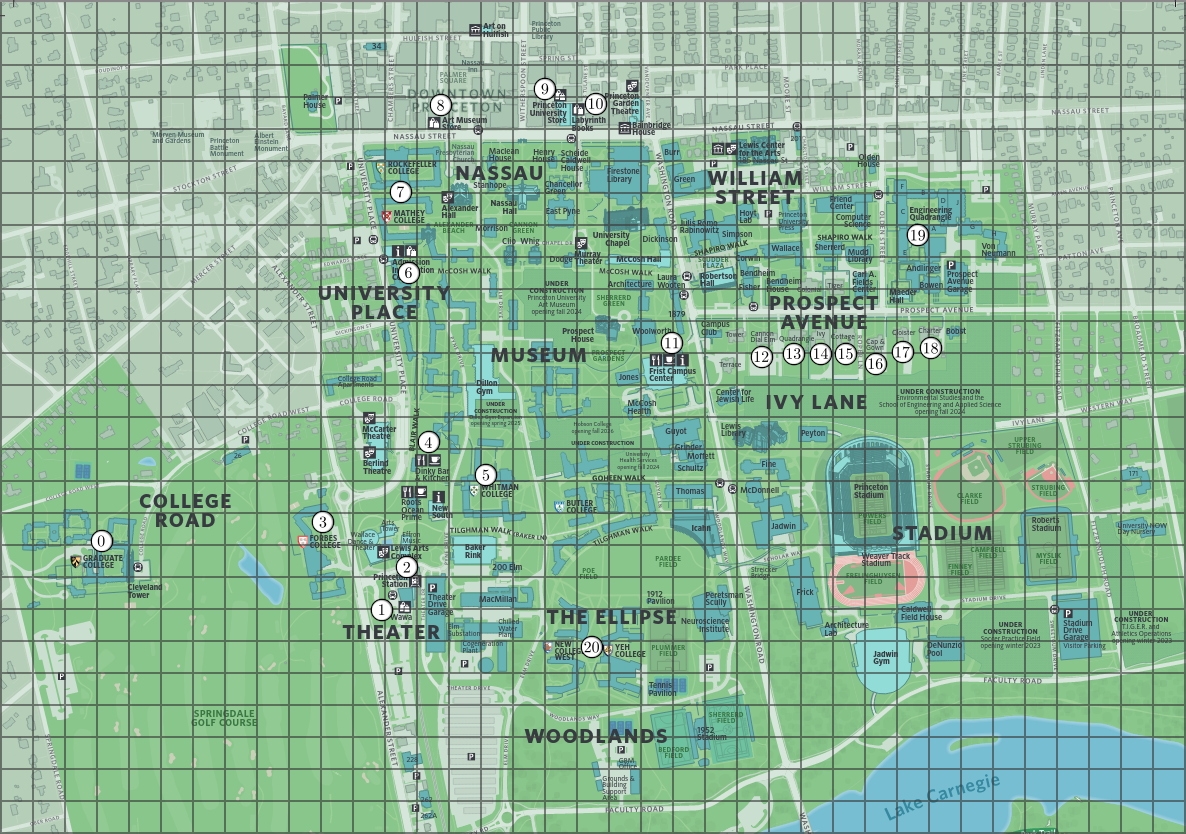
Additionally, you are given a data set with \(n\) labeled
transaction summaries. In your implementation you can assume
\(n\) is always at least 1. A transaction summary is an array of
\(m\) non-negative numbers, one per location, representing the
amount of money spent there using a particular credit card. A
label is either clean or fraud,
indicating whether a fraudulent transaction was detected in the
corresponding transaction summary. Here is an example of
one. Each number corresponds to a vertex in the graph (e.g. the
first number represent the amount of money spent at "Graduate
College," the leftmost point).
| 5 | 6 | 7 | 0 | 6 | 7 | 5 | 6 | 7 | 0 | 6 | 7 | 0 | 6 | 7 | 0 | 6 | 7 | 0 | 6 | 7 | clean |
You will create a simple machine learning model that learns from
this data set, in order to label new transaction summaries as
either clean or Fraud. In your code
you will represent these labels using integers, where \(0\)
represents clean and \(1\)
represents fraud.
Before feeding the data into the machine learning model, you
will first reduce the dimension of the input using
a clustering algorithm. This algorithm receives \(m\)
objects of type Point2D (representing locations) as
well as an integer \(k\), which represents the number of
clusters (\(k\) should be at least 1 and at most \(m\)). The
goal is to output a partition of the points into \(k\) clusters
(i.e., groups), such that the points in the same cluster are
similar (in our case, two points are similar if the Euclidean
distance between them is small). Each cluster should be labeled by
an integer between 0 and \(k - 1\). The output format is an
array of \(k\) elements, the \(i\)th of which represents the
total amount of money that transaction summary spent across all
locations in the \(i\)th cluster.
This step is applied not only to make the model more efficient, but it also improves its accuracy by mitigating an overfit of the model to the input data.
Here is what the clustering algorithm should do:
You don't have to implement all these steps from scratch, there
are several helpful classes in algs4.jar that you can use (see the
implementation requirements below).
The following images represent the minimum spanning tree and the clusters obtained from the Princeton locations above, with \(k = 5\) groups/clusters. On the image on the right, the dashed lines represent the edges of the minimum spanning tree that are not in the new graph and the clusters are indicated by colors.
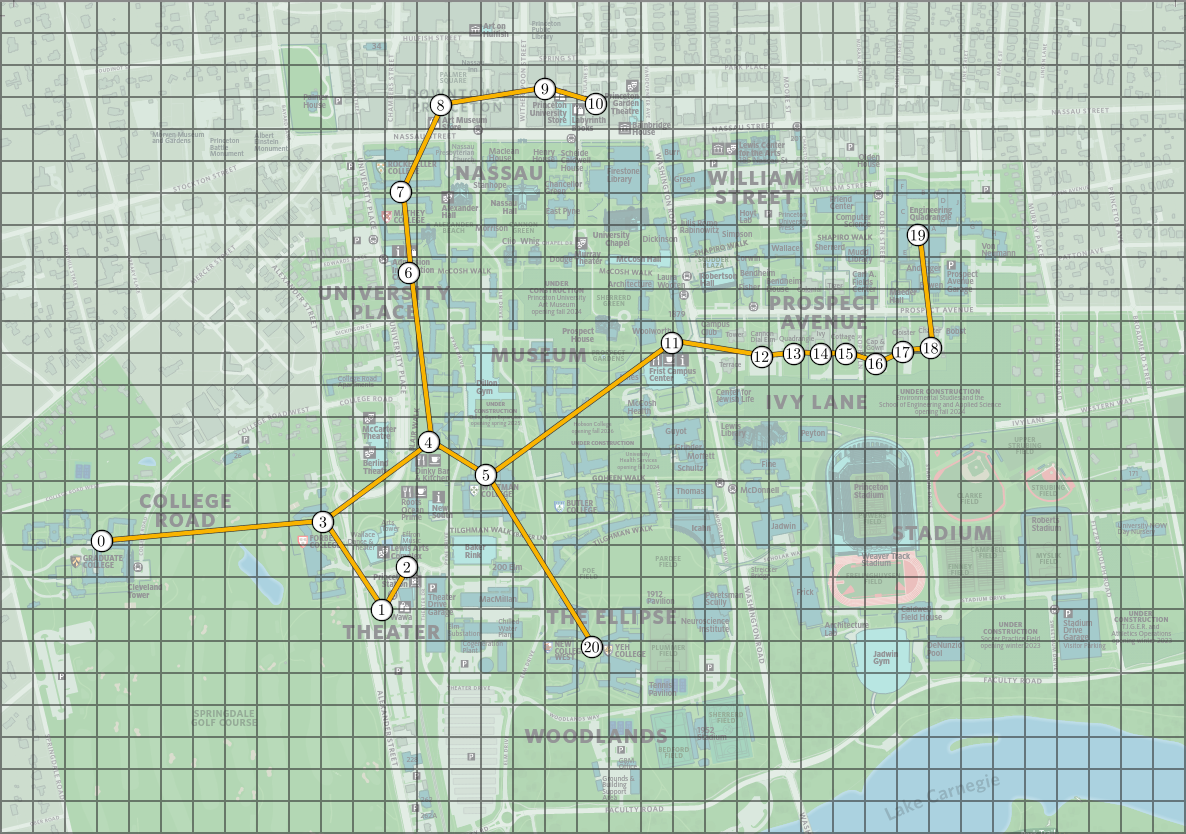
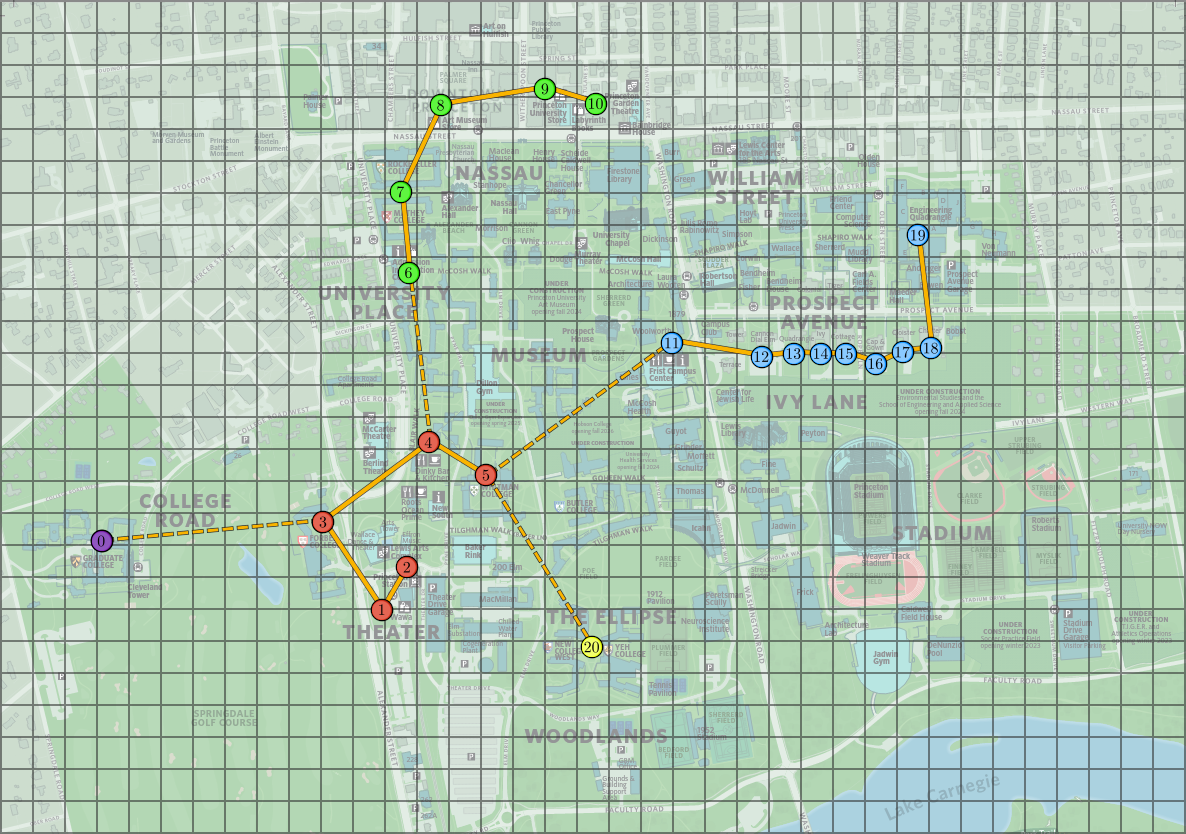
To help you test your code, we provide a file called princeton_locations.txt which starts with the number of locations and then contains one line per location, with the coordinates of the point. The points in this file follow the order of the above images (so again, the first point represent the "Graduate College," the leftmost one in the image). We also include a file princeton_locations_mst.txt that contains the edges of the minimum spanning tree of this graph.
With the clusters above, we can color the transaction summary by the corresponding cluster color and compute the array obtained by reducing its dimensions.
| 5 | 6 | 7 | 0 | 6 | 7 | 5 | 6 | 7 | 0 | 6 | 7 | 0 | 6 | 7 | 0 | 6 | 7 | 0 | 6 | 7 | Original |
| 5 | 26 | 24 | 39 | 7 | Reduced |
Clustering Algorithm. Write a
class Clustering.java that implements the above
clustering algorithm, by implementing the following API:
public class Clustering {
// run the clustering algorithm and create the clusters
public Clustering(Point2D[] locations, int k)
// return the cluster of the ith point
public int clusterOf(int i)
// use the clusters to reduce the dimensions of an input
public double[] reduceDimensions(double[] input)
// unit testing (required)
public static void main(String[] args)
}
Note that the clusterOf() must return an integer
between \(0\) and \(k-1\) and clusterOf(i) should
only be equal to clusterOf(j) if and only if the
\(i\)th and \(j\)th points are in the same cluster.
Implementation requirements.
You should use
KruskalMST
and CC
to compute a minimum spanning tree and connected components.
Corner cases.
Throw an IllegalArgumentException if:
nullnullclusterOf() is not between \(0\) and \(m - 1\)reduceDimensions() has a length different from \(m\)Unit testing.
Your main() method must call each public constructor and method directly and
help verify that they work as prescribed (e.g., by printing results to standard output).
Performance requirements. Your implementation must achieve the following performance requirements:
clusterOf() should run in \(\Theta(1)\) time.reduceDimensions() should run in \(O(m)\) time.A weak learner is a machine learning model that performs marginally better than making random decisions. In the context of this assignment, this means predicting the right label more than \(50\%\) of the time. You will implement a model known as a decision stump, a really popular choice for weak learners.
A decision stump takes as input a sequence of \(n\) inputs, each
represented by an array of \(k\) doubles (a dimension-reduced
transaction summary). Each one of the inputs can be thought of
as a point in \(k\)-dimensions. Each input is labeled with an
integer, either \(0\) or \(1\) (corresponding
to clean or fraud), which will be
represented by an array of \(n\) integers. Additionally, each
input also has a non-negative weight (this will be useful for
the last part of the assignment), so weights are represented by
an array of \(n\) doubles. From the input data and labels, the
decision stump "learns" a predictor: a function that
takes a single sample (i.e. any array of \(k\) doubles) as input
and outputs a binary prediction, either \(0\) or \(1\)
(i.e. clean or fraud).
To make a prediction the decision stump picks a (hyper)plane parallel to all of the axes except one and labels all points to one side of that plane as \(0\) and points on the other side as \(1\). To do so, the you need to compute three quantities: a dimension predictor \(d_p\), a value predictor \(v_p\) and a sign predictor \(s_p\).
The dimension predictor is an integer between \(0\) and \(k - 1\) that represents the non-parallel dimension/coordinate of the input space. The value predictor is a double that represents where the input space is partitioned (i.e. where the hyperplane crosses its non-parallel axis). The sign predictor is an integer, either \(0\) or \(1\), representing in which direction to partition space, i.e. which side of the plane gets labeled as \(0\) or \(1\).
When making a prediction on a input point \(sample\), if \(s_p = 0\) then the decision stump predicts \(0\) if \(sample[d_p] \leq v_p\) and \(1\) otherwise. But, if \(s_p = 1\) then the decision stump reverses the prediction: \(1\) if \(sample[d_p] \leq v_p\) and \(0\) otherwise.
The values of \(d_p\), \(v_p\) and \(s_p\) are chosen to maximize the weight of correctly classified inputs. This means maximizing the sum of the weights of the inputs such that their predicted label (according to the method of the above paragraph) matches the actual input label.
See the images below for an example with \(n = 8\) inputs of dimension \(k = 2\), where dimensions 0 and 1 correspond to the the x and y axes, respectively. For simplicity, in this example the weight of each point is \(1\). Blue squares correspond to the label \(0\) and red circles to the label \(1\). The best predictor is given by the line in the image on the right: points above the line are labeled as \(0\) and points on the line or below the line are labeled as \(1\).
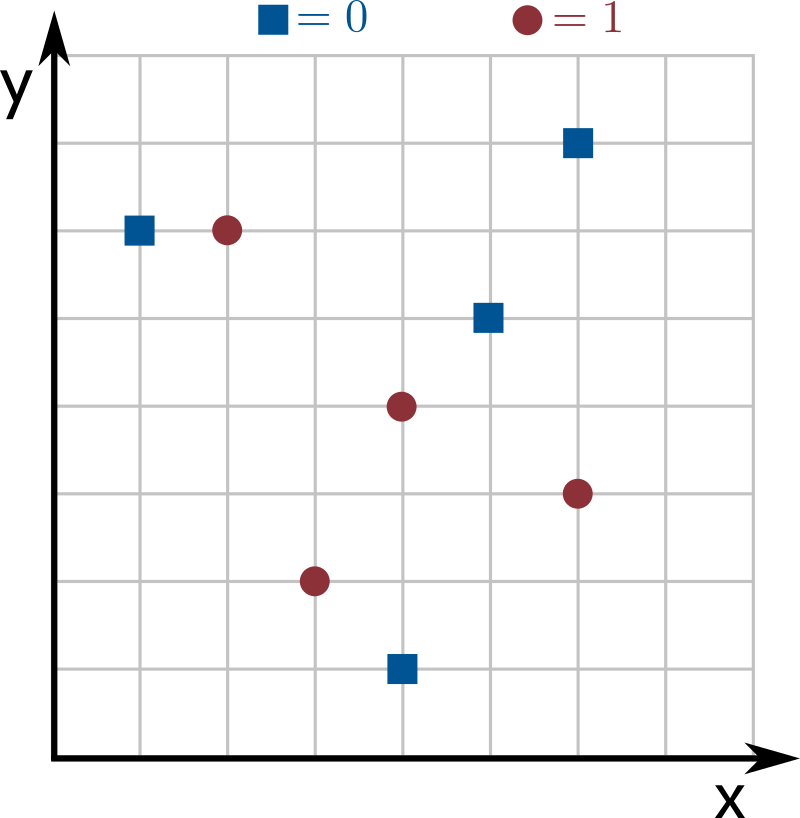
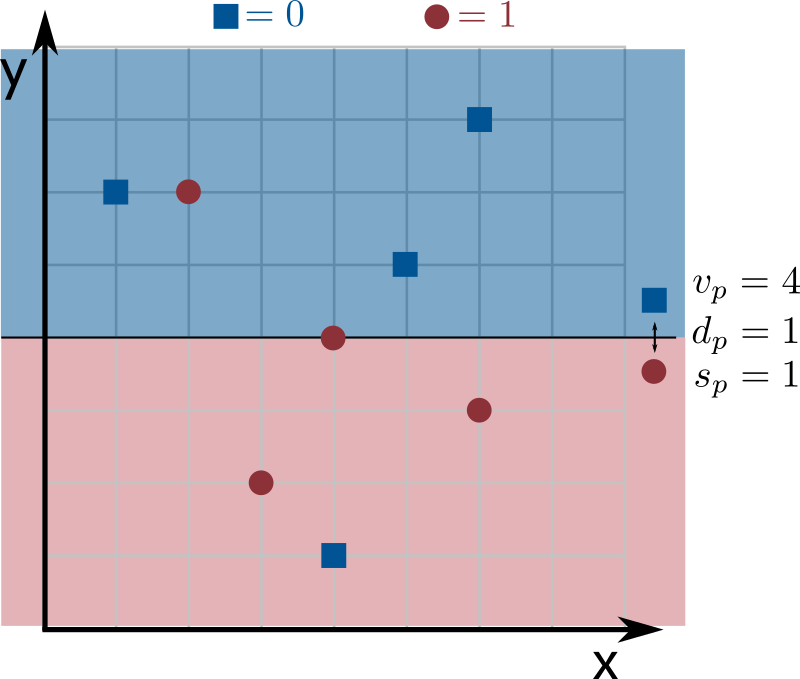
This weak learner mislabels two points, the top circle and the bottom square. Since no other weak learner mislabels less than 2 points, this one is optimal.
Weak Learner. Write a
class WeakLearner.java that implements the above
weak learner, by implementing the following API:
public class WeakLearner {
// train the weak learner
public WeakLearner(double[][] input, double[] weights, int[] labels)
// return the prediction of the learner for a new sample
public int predict(double[] sample)
// return the dimension the learner uses to separate the data
public int dimensionPredictor()
// return the value the learner uses to separate the data
public double valuePredictor()
// return the sign the learner uses to separate the data
public int signPredictor()
// unit testing (required)
public static void main(String[] args)
}
Corner cases.
Throw an IllegalArgumentException if:
null.input, weights, labels or sample are incompatible.weights are not all non-negative.labels are not all either \(0\) or \(1\).Unit testing. We provide you with some code to
help you test your WeakLearner.java
implementation. See the section on "Testing the learners" below.
Performance requirements. Your implementation must achieve the following performance requirements:
dimensionPredictor(), valuePredictor(), signPredictor()
and predict() should run in \(\Theta(1)\)
time.As the name suggests, the weak learner is not a very interesting model. So you will implement a better one using a technique called boosting, which a term that describes algorithms that take weak learners and improve (boost) their quality. In this assignment you will implement a simplified version of an algorithm called AdaBoost (short for Adaptive Boosting), which is an application of the multiplicative weights algorithm.
The input is a sequence of \(n\) labeled transaction summaries,
the \(m\) map locations, as well as an integer \(k\)
representing the number of clusters to cluster the data
into. You should start by creating a Clustering
object so you can map transaction summaries into arrays of
length \(k\), using the dimensionality reduction method. From
now on we use the word input to refer to the reduced transaction
summaries, i.e. the arrays resulting from applied the
dimensionality reduction method to the original transaction
summaries.
AdaBoost is a version of multiplicative weights where the
input points are the experts. The algorithm assigns a
weight to each input point, represented as a double
array of length \(n\). This array is normalized, so that the sum
of its elements is always \(1\). Initially, the weights should
all be set to the same value: \(1 / n\).
The boosting algorithm works in steps or iterations. Each iteration should do the following:
We double the weight of mislabeled inputs to force the algorithm to try harder to predict them correctly in future iterations.
Given a sample to make a prediction on, the model should output the majority vote over the predictions given by the weak learner created in each iteration. This means you should use each weak learner created in each iteration to label the sample point, and then output the label that was predicted the most. In case of a tie, output \(0\).
Boosting Algorithm. Write a
class BoostingAlgorithm.java that implements the above
boosting algorithm, by implementing the following API:
public class BoostingAlgorithm {
// create the clusters and initialize your data structures
public BoostingAlgorithm(double[][] input, int[] labels, Point2D[] locations, int k)
// return the current weights
public double[] weights()
// apply one step of the boosting algorithm
public void iterate()
// return the prediction of the learner for a new sample
public int predict(double[] sample)
// unit testing (required)
public static void main(String[] args)
}
Corner cases.
Throw an IllegalArgumentException if:
null.null.input, labels, locations
or sample are incompatible.labels are not all either \(0\) or \(1\).Unit testing. We provide you with some code to
help you test your Boosting.java
implementation. See the section on "Testing the learners" below.
Performance requirements. Your implementation must achieve the following performance requirements:
weights() should run in \(\Theta(1)\) time.predict() should call the
WeakLearner's predict() method \(T\) times and the
Clustering's reduceDimensions() method once, where
\(T\) is the number of iterations done so fariterate() should create one WeakLearner object and then take \(O(n)\) time.
To help you test your programs, we provide a data
type DataSet.java, whose constructor requires one
string argument, a filename, and reads the contents of that
file.
DataSet data type. The API of
class DataSet.java provided to you:
public class DataSet {
public int n, m;
public Point2D[] locations;
public double[][] input;
public int[] labels;
public DataSet(String filename)
}
A classical way of testing machine learning models is by partitioning labeled data into two data sets: a training and a test data set. The model is trained using the training data, and then it is tested on the test data set. We assess the quality of the model using a very simple metric called accuracy: the fraction of correct predictions. This metric can be used on the training, test or all inputs.
We provide several files that have been pre-partitioned into
training and test data sets, named accordingly. Below is a
sample client to test the BoostingAlgorithm.java
model (we leave it up to you to modify it to work with
the WeakLearner.java). It takes two filenames
(training and test data set files), an integer \(k\) (the number
of clusters for dimensionality reduction), and an integer \(T\)
(the number of iterations of the boosting algorithm) as
command-line arguments. It trains the model on the training data
set and calculates the accuracy in the training and test data
sets.
public static void main(String[] args) {
// read in the terms from a file
DataSet training = new DataSet(args[0]);
DataSet test = new DataSet(args[1]);
int k = Integer.parseInt(args[2]);
int iterations = Integer.parseInt(args[3]);
// train the model
BoostingAlgorithm model = new BoostingAlgorithm(training.input, training.labels,
training.locations, k);
for (int t = 0; t < iterations; t++)
model.iterate();
// calculate the training data set accuracy
double trainingAccuracy = 0;
for (int i = 0; i < training.n; i++)
if (model.predict(training.input[i]) == training.labels[i])
trainingAccuracy += 1;
trainingAccuracy /= training.n;
// calculate the test data set accuracy
double testAccuracy = 0;
for (int i = 0; i < test.n; i++)
if (model.predict(test.input[i]) == test.labels[i])
testAccuracy += 1;
testAccuracy /= test.n;
StdOut.println("Training accuracy of model: " + trainingAccuracy);
StdOut.println("Test accuracy of model: " + testAccuracy);
}
To help you test your code, we provide two data sets, one called princeton_training.txt and one called princeton_test.txt. Both use the locations from the map described in the beginning of the assignment, and the inputs and labels were generated using a simulation. Here are two example runs of the previous client with both models you implemented, and the expected output:
~/Desktop/fraud> java-algs4 WeakLearner princeton_training.txt princeton_test.txt Training accuracy of model: 0.69125 Test accuracy of model: 0.67 ~/Desktop/fraud> java-algs4 BoostingAlgorithm princeton_training.txt princeton_test.txt 5 100 Training accuracy of model: 0.92375 Test accuracy of model: 0.805
Note that the weak learner in the above test was trained with no dimensionality reduction (which is equivalent to setting \(k = m\)) and using uniform weights, that is, all weights are 1.
Submission.
Submit only Clustering.java, WeakLearner.java and BoostingAlgorithm.java.
We will supply algs4.jar.
You may not call library functions except those in
those in java.lang, java.util, and algs4.jar.
Finally, submit readme.txt
and acknowledgments.txt
files and answer the questions.
Grading.
file points Clustering.java12 WeakLearner.java12 BoostingAlgorithm.java12 readme.txt4 40
Reminder: You can lose up to 4 points for poor style
and up to 4 points for inadequate unit testing.